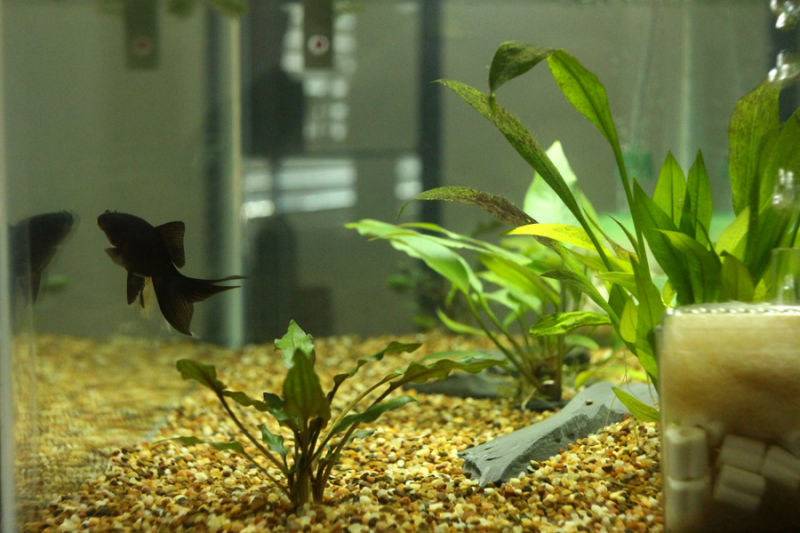
update: second fish and more plants
I added the Amazon Sword (I think that’s what it is) the Melon Sword, and the Cryptocoryne a little over two weeks ago. The second goldfish I added about ten days ago. I wasn’t planning on planting more plants, but the Petco near my house was closing, and everything was on sale. The goldfish have eaten most of the anacharis, and it’s not growing any when I put it in a separate tank, even if I fill that tank with old aquarium water.

I’ve set this tank up in a very old-fashioned way, contrary to many of the current popular beliefs about how goldfish should be kept. It has gravel (not too controversial, but there are plenty of people who say goldfish should have no substrate) it has live plants (rarely done because goldfish like to eat everything) it is “only” 20 gallons (many contend that a fancy goldfish needs 20 gallons, and each additional fish requires and additional ten gallons - some think a single goldfish needs 50 or more gallons). It uses two small box filters (current wisdom is goldfish need very powerful filters because they’re “dirty” fish).
And yet the fish are healthy, the plants are doing ok (they should do better as the tank ages some, it’s still very fresh) and water tests clean. I was reading a couple of old books about keeping goldfish, and figured I’d go with the advice of those who were setting up aquariums before manufacturers had all sorts of gadgetry to sell - which then became “necessary” to keep fish.
The first thing, that all older books stress repeatedly is the importance of surface area, not tank volume, for the well being of the fish. So I chose a 20 gallon “long” tank, it has the same volume as the normal 20 gallon tank size, obviously, but its shorter height and increased length afford much more water surface area (roughly the same as a conventional 29 gallon tank). I don’t know when or why people shifted away from surface area to volume being more important for fish - but the arguments for surface area being of primary importance make more sense to me. These books were written when many people set up tanks without any filtration at all, and often no or minimal aeration, so they had to know how to make that work. The surface of the water is where the water expels CO2 and absorbs oxygen, the water volume is simply swimming space.
Instead of filters, many used snails and mussels to break down waste and clean the water. Live plants were of extreme importance for absorbing ammonia, nitrates, etc. with the added benefit of providing some oxygen during the daytime. I have filters, but I may add snails soon enough. Not sold on the mussels though.
The filters I’ve had plenty of experience with, and have already found the simple box filter to have plenty of advantages over the conventional HOB power filter. I have two in this tank mostly because I wanted to compare two different brands, but also because it allows me to remove and clean one filter, while the other stays in the tank, so I don’t have to worry about killing the beneficial bacteria that live in the filters, and accidentally causing the tank to “crash”. The bacteria convert waste chemicals from the fish into nitrates, and are necessary to keep the water from turning toxic in short order. The plants also absorb the nitrates, so everything in the tank basically relies on their presence to stay healthy. The idea that goldfish need especially heavy filtration because they’re “dirty” seems to be a misconception, stemming from the fact that goldfish, like all coldwater fish, need more highly oxygenated water (than tropical types) to survive.
Interestingly, when I see the way goldfish aquariums are set up by Japanese and Chinese hobbyists, they more closely resemble what I’m doing than what most American aquarists recommend.